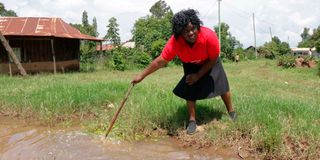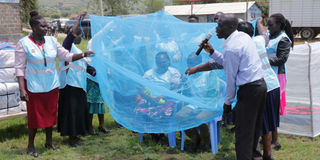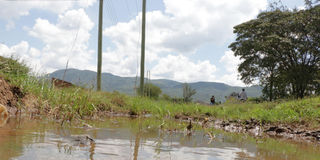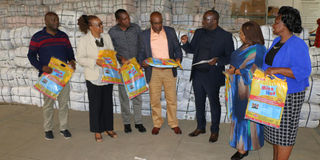Communities in Baringo fight back against malaria with local solutions and mosquito nets

Iven Yagan a resident of Muserechi village in Baringo tries to unclog water in a trench next to her compound that emanates from Kiplombe Hills. The area is one of the Malaria endemic in Baringo County with residents pointing out poor drainage as the main source of increase in mosquito breeding.
What you need to know:
- The rains that bring life to the hills also bring the threat of more stagnant water and more mosquitoes.
- The absence of a well-equipped dispensary remains a significant problem for the community.
Nestled at the foot of Kiplombe Hills in Muserechi, Baringo County, Iven Yagan’s home is surrounded by the serene beauty of nature. Yet, the lush landscape hides a deadly secret, stagnant waters that collect at the base of the hills.
This natural water source though seemingly beneficial to some locals and livestock in the largely pastoralist community is a breeding ground for mosquitoes, the vectors of malaria, a disease that has plagued Yagan and her three children for years.
Yagan lives in a humble home that overlooks the hills and the stagnant water formed by the run-off from the hills has been a constant presence, especially during the rainy season.
“The mosquitoes' constant buzzing around my house is an all-too-familiar sound throughout the year, a precursor to nights of fever, chills, fatigue and eventual sickness. Every time it rains the water collects near our home and soon after the mosquitoes come," Yagan explains.
"My children, one of whom is battling lupus, and I, have been sick many times. Malaria is always in our minds because it's a fear that we live with," she adds.
Yagan’s story is not unique in Baringo where many families face the same challenge. For Mary Wambui, she knows the true cost of malaria all too well.

Residents of Muserechi in Baringo at a treated mosquito nets distribution exercise. According to the Ministry of Health, Baringo county falls under the seasonal malaria transmission zone which is associated with periodic amplification of morbidity in the wet season prompted by limited immunity in inhabitants.
Wambui has witnessed the same stagnant waters and the swarms of mosquitoes that breed there. However, here, the challenge of malaria has often meant more than just fighting the illness.
It has meant embarking on a long arduous journey to find treatment for her children, four boys and one girl.
Whenever her children fell ill with malaria, she had to make a 30-kilometre trek from Muserechi over rough terrain in search of medication to the nearest health facility in Eldama Ravine Sub-county Hospital that could provide the care they needed.
By then, the closest dispensary Esageri Health Centre was severely under-resourced and lacked the essential reagents for testing and treating malaria.
Health workers at the local dispensary where she sought help after herbs from the traditional healer failed to cure her son advised that she make the journey to Eldama Ravine Hospital.
With no reliable local option, Wambui's only choice was to travel far from her home, incurring significant costs and enduring the anxiety of being away from her sick children.
“The frequent trips were exhausting and expensive, costing at least Sh7,000. Each time one of my children got sick, I knew I would have to find the money for transport and the time to make the journey. It was never easy as long distances also meant that I often had to leave other children alone at home or under the care of neighbours,” Wambui recounts.
Determined to protect her family from the constant threat of malaria, she decided to take action beyond seeking medical treatment.

Community health promoters demonstrate how to use insecticide-treated bed nets to residents of Muserechi in Baringo County.
Through community health promoters she learned about the importance of environmental management in preventing the spread of malaria and took it upon herself to make changes in her immediate surroundings.
“I realised that the stagnant water and the overgrown bushes around our home were part of the problem. I decided to clear the bushes and try to drain the water wherever I could. It wasn’t easy but I was desperate to do anything to keep my children and myself from getting sick,” Wambui says.
She says her proactive approach soon began to yield results, with fewer mosquito bites and a noticeable decrease in the number of malaria cases in her household.
“We worked hard, but it was worth it. Seeing my children healthy and not having to make those long trips as often made all the difference. It gave us hope,” she says.
Though the challenges of malaria are still present, Wambui and Yagan’s simple initiatives are inspiring a greater awareness of preventive measures that can be taken to reduce the risk of malaria infection, especially in Baringo County. Despite these improvements, she still worries about the future.
The rains that bring life to the hills also bring the threat of more stagnant water and more mosquitoes. The absence of a well-equipped dispensary remains a significant problem for the community, and Wambui knows that her makeshift efforts are no substitute for professional medical care.

The lush landscape at the foot of Kiplombe Hills in Muserechi, Baringo County, hides a deadly secret, stagnant waters. This natural water source though seemingly beneficial to some locals and livestock in the largely pastoralist community is a breeding ground for mosquitoes, the vectors of malaria.
“We have learned that we have to take care of ourselves and each other. Even though it’s hard, I know that every bit of effort we put in makes a difference. We may not have much, but we have each other, and that gives us strength,” she told Healthy Nation.
Yagan and Wambui's situations are emblematic of the struggles faced by many residents of Baringo, where healthcare facilities are scarce, and access to quality medical treatment is somewhat of a luxury.
In Baringo where the terrain ranges from irrigation schemes to highlands soaked by heavy rains and arid zones where pastoralists roam with their cattle, the battle against malaria has been multifaceted.
Koibatek constituency has many cases of highland malaria which happens in seasons and transmissions are usually low or sporadic in warmer weather. In Marigat, the area is surrounded by irrigation scheme projects which make the area prone to malaria due to stagnant waters.
At the Kerio belt, Tiaty East and Tiaty West upsurges are experienced at times as a result of mosquito bites during nomadic pastoralist travels while Marigat also has a high malaria burden.
Due to the population's lack of immunity, outbreaks in highland areas can lead to severe epidemics with higher morbidity and mortality rates compared to endemic areas.

Kenya Medical Supplies Authority officials led by CEO Waqo Dulacha Ejersa at the Nakuru depot. Kemsa has for the first time been roped in to ensure the treated nets funded by the Global Fund and the US government reach beneficiaries in at least 20 malaria-endemic counties.
But thanks to a wave of social behaviour change initiatives, the narrative is shifting and the grip of this deadly disease is slowly loosening.
Malaria, a disease caused by protozoan parasites of the genus Plasmodium and transmitted by female anopheline mosquitoes, is a major cause of morbidity, mortality and loss in productivity in humans. It is preventable and curable.
According to the Ministry of Health, Baringo county falls under the seasonal malaria transmission zone which is associated with periodic amplification of morbidity in the wet season prompted by limited immunity in inhabitants.
Malaria is endemic in the area, and for many, access to medical care is limited, making prevention the best line of defence.
The malaria burden continues to be very high in Baringo, despite recent studies showing that prevalence rates are decreasing across many parts highlighting the need for more aggressive methods of controlling the disease in high transmission areas.
Data from the National Malaria Control Programme- Kenya shows that confirmed positive malaria cases reduced from 40,279 cases in 2021 to 32, 717 in 2022. In 2023, 29,114 cases were recorded.
“Early diagnosis and treatment, Advocacy on social behaviour change and proper use of insecticide-treated bed nets have seen the cases lower,” said County Malaria Control Coordinator Faith Changwony.
Additionally, enhanced surveillance and rapid response systems are crucial to quickly detect and control outbreaks. Ms Changwony said they are still raising awareness and educating local communities about malaria prevention and symptoms, especially in areas where malaria is not commonly experienced.
The official said there is a need to scale up campaigns to distribute insecticide-treated bed nets and spray homes with insecticides while considering new interventions such as using malaria drugs.
High transmission intensity, and reducing morbidity will require enhanced community-wide coverage of these interventions and consideration of additional interventions.
These include expanding indoor residual spraying (IRS), larval source management (which involves both the modification of water habitats and the direct application of larvicides to control mosquito production) and other novel vector control strategies and mass distribution of Long-Lasting Insecticidal Nets (LLINs) by the Kenya Medical Supplies Authority (Kemsa).
With the above measures, malaria incidence is decreasing in the county as noted by a decline from 59/1000 cases in 2021 to 46/1000 and 39/1000 in 2022 and 39/1000 in 2023.
The data shows the county’s malaria test positivity rate was 18 per cent in 2021, 17.7 in 2022 and 17.9 in 2023.
Kemsa has for the first time been roped in to ensure the treated nets funded by the Global Fund and the US government reach beneficiaries in at least 20 malaria-endemic counties.
“There are 10.9 million nets distributed to 22 counties. Four counties have been distributed through other mechanisms but Kemsa has done the distribution in 18 of them," Kemsa CEO Waqo Dulacha Ejersa said.
Since November 2023, a total of 12,477,909 nets have been distributed across 18 counties, reaching 3,941,247 people.
Mr Ejersa said distribution efforts continue nationwide, the focus remains on reaching vulnerable populations and ensuring equitable access to life-saving preventive measures.
Baringo County has received 290,000 free mosquito nets in three sub-counties. The most affected are Eldama Ravine Subcounty which has 95,000 nets, Mogotio 72,000 nets and Baringo South Subcounty, 80,000 nets.
The distribution of mosquito nets by Kemsa is part of a broader effort by local health organizations and the government to combat malaria in rural areas.
The initiative aims to provide every household with mosquito nets and educate residents about the importance of using them correctly.



